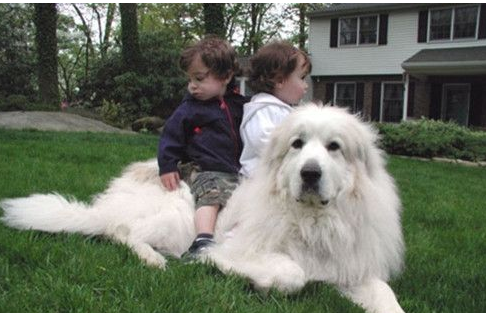How to Train a Great Pyrenees? The Great Pyrenees has a mild and friendly personality and a cute and honest appearance. From some angles, it looks a bit like a Chow Chow. Its fur is as fluffy as that of a Chow Chow, making people unable to resist reaching out and grabbing it. Especially in winter, people even more want to hold it in their arms to keep warm. Unfortunately, the Great Pyrenees is a large breed dog. Adult Great Pyrenees are not suitable for being picked up. Encountering such a lovely creature but not being able to hold it is really a loss. So is the Great Pyrenees suitable for training? And how should we train it?

How to Train a Great Pyrenees? Training Can Be Done Through Induction.
Temperament of the Great Pyrenees:
Under natural circumstances, the temperament of the Great Pyrenees is confident, mild, and friendly. When necessary, it will protect its territory, flock, or family. It usually appears calm, composed, patient, and tolerant. It has a very strong will, is independent and slightly reserved, has a strong sense of responsibility, and is very concerned about the people or animals it is responsible for. It is loyal and brave.
Size of the Great Pyrenees:
The Great Pyrenees is a large breed dog. The shoulder height of male Great Pyrenees is about 27 to 32 inches, and the shoulder height of female Great Pyrenees is about 25 to 29 inches. A 27-inch male Great Pyrenees weighs about 100 pounds, and a 25-inch female Great Pyrenees weighs about 85 pounds. The weight is in proportion to the overall size and constitution of the body. Proportion: The shoulder height is slightly shorter than the body length (the distance from the withers to the back of the thigh <buttocks>), and the proportion is that of a rectangular, well-coordinated dog. The length is slightly greater than the height, and the front and rear angles of the body are coordinated. Constitution: The body of the Great Pyrenees is medium-sized (not particularly fat nor particularly thin). Without touching its bones and muscles, it is easy to be deceived by its thick coat. In harmony with its size and elegant appearance, sufficient bone mass and muscles provide a balanced body structure. Defects: Size - Shoulder height below the lower limit or above the upper limit. Constitution - Bones too heavy or too light, affecting the balance of the body structure.
Training of the Great Pyrenees:
Training a Great Pyrenees involves many aspects and there are also many training methods. Choosing the most suitable training method for your beloved dog is very important. The basic ways of training dogs include four types: reward, punishment, induction, and coercion.
Reward: Reward is a training method that dogs like to accept the most. Through reward measures, the correct actions of dogs can be strengthened, the developed abilities can be consolidated, and the neural activity state of dogs can be adjusted. Generally speaking, it is best to use food encouragement as little as possible, because often giving dogs reward food is easy to cause problems such as gluttony and stealing food. Verbal praise or stroking its back of the ears, back of the neck, top of the head, or below the neck can be used. In fact, the effect of this kind of spiritual reward is not worse than that of material reward.
Punishment: Punishment is an effective means to stop the bad behavior of dogs. When using this means, the trainer must have a serious attitude and a high-pitched and sharp tone.
Severe punishment also includes scolding the dog while pointing at it, throwing stones, books, etc. towards the dog's side forcefully, and whipping and beating with a stick. Of course, it is not a real beating. The main purpose is to pose a threatening posture to the dog. Through the nervous stimulation, it will remember this lesson and not repeat it.
- Induction: For example, if the dog sneaks into the kitchen when the owner is not paying attention and eats up all the food placed there, this behavior of the dog must be firmly punished and not tolerated. The dog can be led back to the place where the food is in the kitchen, and scolded loudly at it with a fierce expression. Raise the stick as if to hit it to make it fear this place and stealing behavior and not repeat the mistake. If one's own dog has a strange habit of eating feces, strict punishment must be taken to make it get rid of this bad habit. The direct punishment method is to put feces and other filth in front of the dog. When the dog eats it, scold and beat it loudly and take away the filth. Try again in the same way in a day or two until the dog no longer eats it.
Training of the Great Pyrenees to Bark:
Barking is originally an innate instinct of dogs and does not need training. However, random barking of dogs without any reason is also very annoying. Therefore, training for barking is very necessary. This training is to make the dog develop a basic training of "barking when commanded to bark and stopping when not allowed to bark." There are many training methods for dog barking. Flower, Pet, and Aquarium Network suggests that it is best to let the puppy gradually develop the habit of obeying the command of "bark" when it is young. In the daily feeding and rearing of puppies, there are many opportunities for training. For example, dogs will make various barking sounds when they are happy, anxious, expectant, vigilant, or angry. Dog trainers should seize these opportunities and issue the "bark" command at the moment the dog barks. When giving food too late or when the dog is restrained by a belt, these can all be opportunities to train obedience to the "bark" command. When the dog hears the command and immediately barks consciously or unconsciously, reward it by giving food or removing its restraint. By persisting in this way for a period of time, a conditioned reflex can be formed and the "bark" training can be successful.
 +86-15501882496
+86-15501882496 +86-15501882496
+86-15501882496
 Contact us:ejucms1@qq.com
Contact us:ejucms1@qq.com Add:920-1002 East Jiefang Road,Wuxi,Jiangsu,China
Add:920-1002 East Jiefang Road,Wuxi,Jiangsu,China